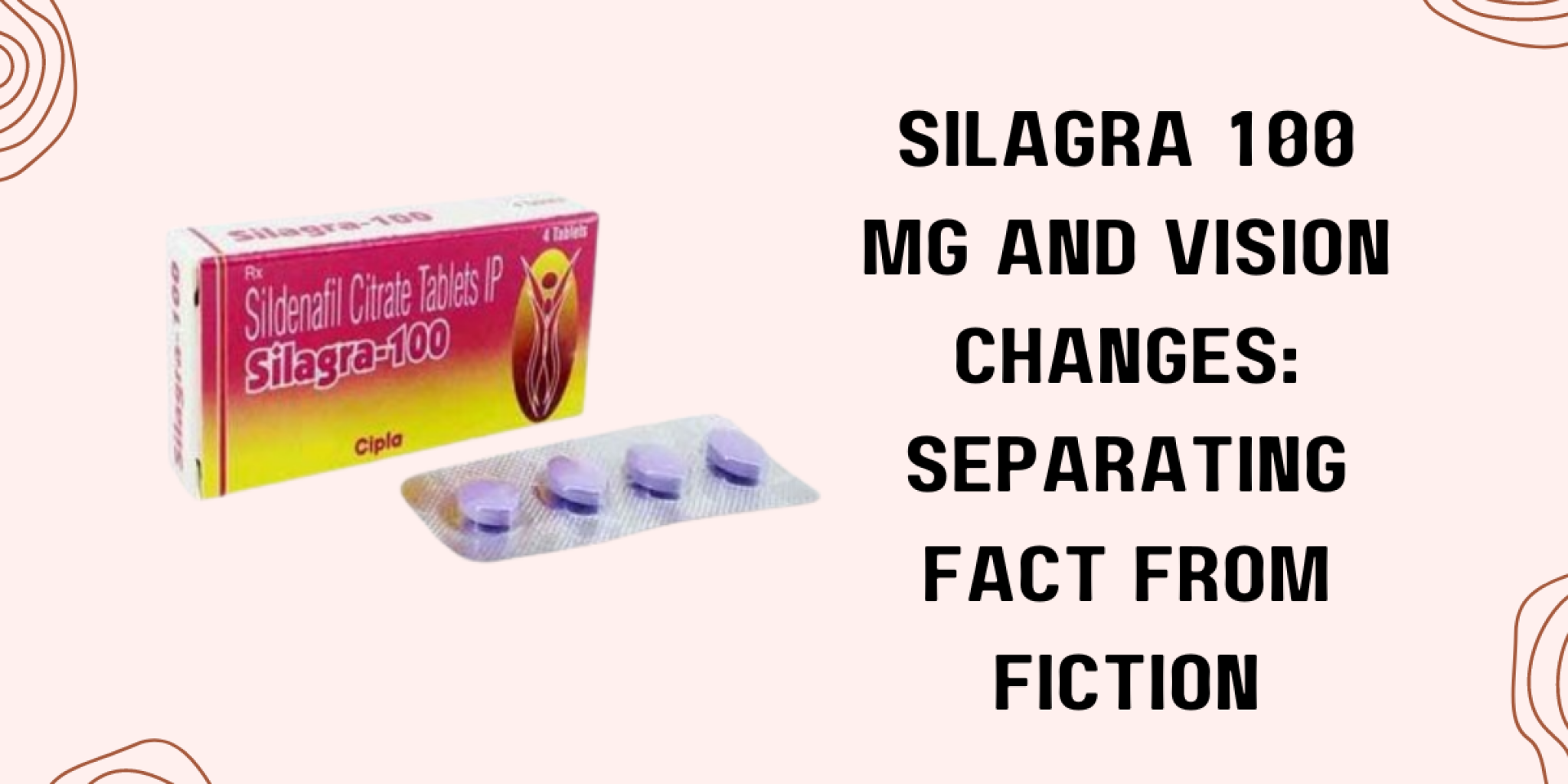Costtallle's blog

When it comes to medications for erectile dysfunction (ED), Silagra 100 mg often emerges as a popular choice. However, along with its efficacy in treating ED, there have been concerns raised regarding potential vision changes associated with its use. In this article, we aim to delve into the relationship between Silagra 100 mg and vision changes, separating fact from fiction.
Understanding Silagra 100 mg
Silagra 100 mg is a medication
belonging to a class of drugs known as phosphodiesterase type 5 (PDE5)
inhibitors. Its active ingredient, sildenafil citrate, works by increasing
blood flow to the penis, facilitating erections in men with ED. Typically,
Silagra is prescribed in a 100 mg dosage, although this may vary depending on
individual factors and the severity of ED.
As with any medication, Silagra
100 mg may cause side effects, ranging from mild to severe. Common side effects
include headaches, flushing, indigestion, and nasal congestion. However, among
the reported side effects, concerns about vision changes have sparked
particular interest and debate.
Vision Changes: Exploring the
Claims
Reports of vision changes
associated with Silagra 100 mg have led to speculation about its safety and
potential risks. These changes may include blurred vision, sensitivity to
light, and changes in color perception. However, it's essential to examine the
evidence available to understand the true nature of these claims.
Clinical studies and trials have
been conducted to assess the safety profile of Silagra 100 mg, including its
impact on vision. While some studies have reported instances of vision changes
among participants, it's crucial to differentiate between correlation and
causation. In many cases, vision changes may be a result of underlying
conditions or other factors unrelated to Silagra usage.
Addressing Misconceptions
Despite scientific evidence
indicating a lack of direct causation between Silagra 100 mg and vision
changes, misconceptions persist. Myths surrounding the medication's supposed
detrimental effects on vision continue to circulate, fuelled by misinformation
and anecdotal accounts.
It's essential to debunk these
misconceptions with factual information grounded in scientific research. By
doing so, we can help individuals make informed decisions about their
healthcare and alleviate unnecessary concerns about Silagra 100 mg's safety.
Risk Factors and Precautions
While Silagra 100 mg is generally
well-tolerated, certain individuals may be at higher risk for experiencing
vision changes or other side effects. Factors such as age, pre-existing eye
conditions, and concurrent medication use can influence an individual's
response to Silagra.
As a precautionary measure,
individuals considering Silagra 100 mg should consult with their healthcare
provider. Healthcare professionals can assess their medical history, risk
factors, and suitability for the medication, providing personalized guidance
and recommendations.
Alternative Explanations for
Vision Changes
It's essential to consider
alternative explanations for vision changes reported by individuals using
Silagra 100 mg. Lifestyle factors such as smoking, alcohol consumption, and
poor diet can contribute to vision problems. Additionally, underlying health
conditions such as diabetes and hypertension may affect ocular health independent
of medication use.
By addressing these alternative
explanations, we can contextualize the reported vision changes and avoid
attributing them solely to Silagra 100 mg.
Patient Experiences and
Testimonials
Real-world feedback from
individuals who have used Silagra 100 Mg
can offer valuable insights into its effects on vision. While anecdotal
evidence should be taken into account, it's essential to balance it with
scientific data and clinical findings.
Understanding that experiences
may vary among individuals can help temper expectations and foster open
dialogue between patients and healthcare providers.
Conclusion
In conclusion, while concerns
about vision changes associated with Silagra 100 mg are understandable,
separating fact from fiction is crucial. By examining the available evidence,
addressing misconceptions, considering risk factors, and acknowledging
alternative explanations, we can provide a comprehensive understanding of
Silagra 100 mg's safety profile. Ultimately, informed decision-making guided by
healthcare professionals is paramount in ensuring safe and effective treatment
for erectile dysfunction.

In the realm of reproductive health, concerns about fertility often loom large. For individuals and couples hoping to conceive, any factors that could potentially impact fertility warrant careful consideration. One such factor that has garnered attention is the use of medications like Poxet 90 Mg. In this article, we delve into the relationship between Poxet 90 Mg and fertility, examining its mechanisms, potential effects, and the broader implications for reproductive health.
Understanding Poxet 90 Mg:
Poxet 90 Mg is a medication primarily prescribed for the treatment of premature ejaculation (PE). It belongs to a class of drugs known as selective serotonin reuptake inhibitors (SSRIs), which are commonly used to treat depression and anxiety disorders. However, Poxet 90 Mg is specifically formulated to target PE by delaying ejaculation, thus extending the duration of sexual activity.
Fertility and Reproductive Health:
Before delving into the potential impact of Poxet 90 Mg on fertility, it's essential to understand the significance of fertility in individuals and couples. Fertility not only affects the ability to conceive but also plays a crucial role in overall well-being and quality of life. Various factors, including age, health status, lifestyle choices, and environmental factors, can influence fertility. Maintaining optimal reproductive health is therefore paramount for those hoping to start or expand their families.
Poxet 90 Mg and Its Impact on Fertility:
The relationship between Poxet 90 Mg and fertility is complex and not fully understood. While Poxet 90 Mg is primarily indicated for PE and does not directly target fertility, some studies have raised concerns about its potential effects on reproductive health. SSRIs, including Poxet 90 Mg, have been associated with changes in libido, erectile function, and semen parameters, all of which can impact fertility.
Existing research on the effects of Poxet 90 Mg on fertility is limited and inconclusive. Some studies suggest that SSRIs may have adverse effects on sperm quality and function, potentially reducing fertility in men. However, other research indicates that any changes in semen parameters are typically reversible upon discontinuation of the medication. More comprehensive studies are needed to elucidate the precise mechanisms underlying the relationship between Poxet 90 Mg and fertility.
Expert Insights and Recommendations:
Healthcare professionals play a crucial role in guiding individuals and couples through decisions regarding medication use and its potential impact on fertility. While Poxet 90mg may offer benefits for those struggling with PE, it's essential to consider the potential implications for fertility. Consulting with a healthcare provider can provide valuable insights and personalized recommendations based on individual circumstances.
Alternative Approaches to Maintaining Reproductive Health:
In addition to medication, there are various lifestyle modifications and alternative treatments that can support reproductive health. Maintaining a healthy diet, regular exercise, managing stress, and avoiding harmful substances like tobacco and excessive alcohol can all contribute to optimal fertility. For those experiencing PE, counselling, behavioural techniques, and other non-pharmacological interventions may offer viable alternatives or complementary approaches to medication.
Conclusion:
The relationship between Poxet 90 Mg and fertility is multifaceted and merits careful consideration. While Poxet 90 Mg can be an effective treatment for PE, its potential impact on fertility underscores the importance of informed decision-making and open communication with healthcare providers. By weighing the benefits and potential risks, individuals and couples can make informed choices that align with their reproductive goals and overall well-being.

Erectile dysfunction (ED) affects millions of men worldwide, causing distress and impacting their quality of life. Fortunately, advancements in medicine have led to the development of effective treatments, one of which is Vidalista. In this comprehensive guide, we will delve into what Vidalista is, how it works, its uses, effectiveness, potential side effects, and much more to provide you with a thorough understanding of this medication and its role in managing ED.
What is Vidalista?
Vidalista is a medication classified as a phosphodiesterase type 5 (PDE5) inhibitor. Its active ingredient, Tadalafil, works by increasing blood flow to the penis during sexual stimulation, thereby helping men achieve and maintain an erection. Available in various dosages and forms, including tablets and oral jelly, Vidalista offers flexibility in treatment options for individuals with ED.
Uses of Vidalista:
The primary use of Vidalista is the treatment of erectile dysfunction. However, it is also sometimes prescribed off-label for conditions such as pulmonary arterial hypertension. When compared to other ED medications, Vidalista stands out for its longer duration of action, allowing for spontaneity in sexual activity.
How to Take Vidalista:
Taking Vidalista as prescribed by a healthcare professional is crucial for its effectiveness and safety. Dosage instructions may vary based on individual needs, but typically, it is recommended to take the medication about 30 minutes to an hour before anticipated sexual activity. Vidalista should not be taken more than once a day, and it can be taken with or without food. It's essential to avoid alcohol and grapefruit juice, as they may interact with the medication.
Effectiveness of Vidalista:
Clinical studies have demonstrated the efficacy of Vidalista in treating ED, with many men experiencing significant improvements in their ability to achieve and maintain erections. Factors such as age, underlying health conditions, and psychological factors may influence its effectiveness. It's essential to have realistic expectations and consult a healthcare professional for personalized advice.
Side Effects and Risks:
Like any medication, Vidalista can cause side effects, although they are usually mild and transient. Common side effects may include headache, flushing, nasal congestion, and indigestion. In rare cases, more serious adverse reactions such as priapism (prolonged erection) and sudden vision loss may occur. It's crucial to seek medical attention if any concerning symptoms arise.
Buying Vidalista:
Vidalista is available by prescription, and it's important to obtain it from a reputable source. While online purchasing offers convenience, it's essential to ensure the authenticity and safety of the medication. Counterfeit products can pose significant health risks, so it's advisable to purchase from licensed pharmacies or trusted online retailers.
Lifestyle Tips for Maximizing Vidalista's Benefits:
In addition to taking Vidalista, adopting healthy lifestyle habits can enhance its effectiveness and overall well-being. Regular exercise, a balanced diet, adequate sleep, and stress management techniques can all contribute to better erectile function. It's also essential to communicate openly with your partner and address any underlying relationship issues.
Frequently Asked Questions (FAQs) about Vidalista:
Addressing common concerns and queries can help individuals make informed decisions about Tadalafil. FAQs may include inquiries about its onset of action, duration of effect, potential interactions with other medications, and suitability for specific health conditions. Consulting a healthcare professional is the best way to get accurate and personalized answers to these questions.
Conclusion:
Vidalista offers a safe and effective treatment option for men experiencing erectile dysfunction. By understanding how Vidalista works, its uses, potential side effects, and other relevant information, individuals can make informed decisions about their ED management. It's essential to consult a healthcare professional for personalized advice and guidance tailored to individual needs and circumstances. With proper care and adherence to treatment guidelines, Vidalista can help men regain confidence and improve their sexual health and overall quality of life.

Cenforce 50 mg is a medication primarily prescribed for the treatment of erectile dysfunction (ED), a condition affecting millions of men worldwide. While it's designed to improve sexual performance and satisfaction, like any medication, it can come with side effects. Managing these side effects is crucial for enhancing comfort and ensuring the medication's effectiveness. In this article, we'll delve into understanding Cenforce 50 Mg, its potential side effects, and valuable tips for managing them while enhancing overall comfort.
Understanding Cenforce 50 Mg:
Cenforce 50 mg belongs to a class of medications called phosphodiesterase type 5 (PDE5) inhibitors. It works by increasing blood flow to the penis during sexual stimulation, thereby aiding in achieving and maintaining an erection. Commonly prescribed for ED, it's essential to follow dosage guidelines and understand its mechanism of action to maximize its benefits while minimizing risks.
Potential Side Effects of Cenforce 50 Mg:
While Cenforce 50 mg is generally well-tolerated, like any medication, it can cause side effects. Common side effects may include headache, dizziness, flushing, nasal congestion, and indigestion. These effects are often mild and temporary, resolving as the body adjusts to the medication. However, some individuals may experience more severe side effects, such as vision changes, hearing loss, or priapism (prolonged erection), which require immediate medical attention. Factors such as age, underlying health conditions, and concurrent medication use can influence the likelihood and severity of side effects.
Tips for Managing Side Effects:
- Consultation with healthcare provider: Before starting Cenforce 50 mg or any medication, it's crucial to consult a healthcare provider. They can assess your medical history, current medications, and any risk factors to determine if Cenforce 50 mg is suitable for you. Additionally, they can provide guidance on dosage adjustments and monitor for potential side effects.
- Dosage adjustment: If you experience bothersome side effects with Cenforce 50 mg, your healthcare provider may recommend adjusting the dosage. Sometimes, lowering the dose can help alleviate side effects while maintaining efficacy. Never modify the dosage without consulting a healthcare professional.
- Lifestyle modifications: Certain lifestyle factors can influence the side effects of Cenforce 50 mg. Avoiding excessive alcohol consumption, smoking, and recreational drug use can help reduce the likelihood of side effects. Additionally, maintaining a healthy diet, regular exercise, and managing stress levels can contribute to overall well-being and minimize side effects.
- Over-the-counter remedies: For mild side effects such as headache or indigestion, over-the-counter remedies like pain relievers or antacids may provide relief. However, it's essential to consult a pharmacist or healthcare provider before taking any additional medications, as they may interact with Cenforce 50 mg.
- Recognizing and reporting severe side effects: While rare, severe side effects of Cenforce 50 mg require immediate medical attention. These may include sudden vision or hearing loss, chest pain, or an erection lasting more than four hours. If you experience any of these symptoms, seek medical help promptly.
Enhancing Comfort While Taking Cenforce 50 Mg:
In addition to managing side effects, enhancing comfort while taking Cenforce 50mg involves creating a supportive environment and addressing psychological aspects of sexual health. Communication with your partner about any concerns or preferences can foster a more satisfying sexual experience. Additionally, seeking psychological support, either individually or as a couple, can help address any underlying anxiety or relationship issues contributing to ED.
Conclusion:
Cenforce 50 mg can be an effective treatment for ED, but it's essential to understand its potential side effects and how to manage them for optimal comfort and safety. Consulting a healthcare provider, following dosage guidelines, and making lifestyle modifications can help minimize side effects while maximizing the medication's benefits. Additionally, enhancing comfort while taking Cenforce 50 mg involves open communication with your partner and addressing any psychological factors impacting sexual health. By taking a proactive approach to medication management and sexual well-being, individuals can enjoy a fulfilling and satisfying sex life while minimizing potential risks.
